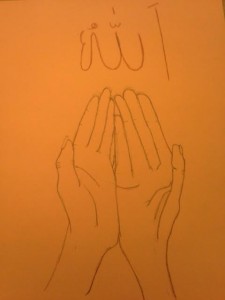Portfolio Response to The Beggar’s Strike
ø
I drew hands in dua (prayer, suplication) to God, Allah, to reflect on The Beggar’s Strike. The classic image of begging is holding hands out, desperate for money and help from others. The image of the poor and needy is stigmatized in The Beggar’s Strike, and the government harshly punishes the beggars to clear the streets in order to create a better tourist destination for the city. I could imagine beggars holding their hands out to people on the street, just as I’ve seen beggars in India and Pakistan, in big cities like Chicago, and even in Harvard Square. The Beggar’s Strike brings to light the mistreatment of the poor and the outlook the characters had–viewing them as unimportant and insignificant.
I contrasted the idea of begging presented in The Beggar’s Strike with begging to God, that I learned is good and what Muslims ought to do, in the sense that we should ask God for anything and everything, and while praying it is custom to hold one’s hands out as if begging. In the drawing, it is possible to look at just the bottom half of the drawing and see a beggar’s hands on the street, trying to make a living off meager coins. However, taking in the entire picture with Allah written in Arabic above the hands makes it clear that this person is actually begging to God. I wondered on the fine line between these types of begging and how we should be compassionate to those who must beg because we do the same. It is necessary to respect all people and help the poor and needy.


